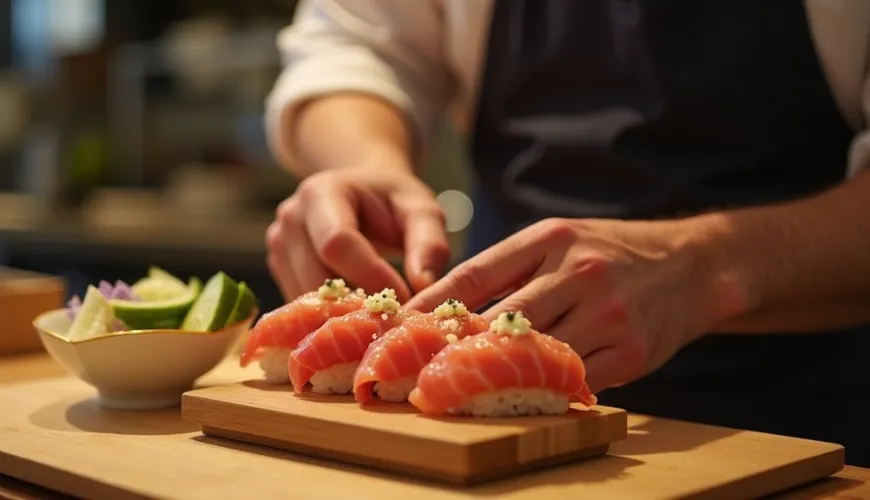
How does hosomaki differ from maki and why is it worth trying

Hosomaki - The Simple Elegance of Japanese Sushi
Sushi is not only a culinary experience but also a cultural reflection of Japanese precision, aesthetics, and respect for ingredients. Among the most well-known types of sushi are often rolls filled with colorful ingredients, such as maki or uramaki. However, one of the basic types, hosomaki, deserves its place in the spotlight perhaps more than it initially seems.
Hosomaki, which translates literally to "thin roll," is a minimalist variant of maki sushi. It contains only one main ingredient, surrounded by a layer of seasoned rice and a sheet of nori seaweed. This simplicity celebrates the purity of flavors and perfect craftsmanship.
Hosomaki vs. Maki - What is the Difference?
The terms “hosomaki” and “maki sushi” are often confused or considered the same. However, the truth is a bit more complex. The word "maki" (巻き) in Japanese means "roll" and serves as a general term for all types of rolled sushi. This includes futomaki (thick rolls), uramaki (inside-out rolls with rice on the outside), and the aforementioned hosomaki, which are the thinnest in this group.
The key difference between hosomaki and other maki types lies primarily in their size and content. While futomaki can contain several different ingredients, including vegetables, fish, and sauces, hosomaki sticks to extreme simplicity. Each roll contains only one filling – such as raw tuna, cucumber, or avocado. This simplicity highlights the pure taste of the main ingredient without any distracting elements.
The Most Popular Types of Hosomaki
In sushi bars, hosomaki often appears as part of larger sets or as a light snack. Among the classics are:
- Kappa maki – filled with fresh cucumber
- Avocado maki – with creamy avocado
- Tekka maki – also known as hosomaki teka, rolls filled with raw tuna
- Sake maki – with fresh salmon
- Shinko maki – with yellow pickled radish
Special attention is deserved by tekka maki, sushi with tuna. This type of sushi got its name from “tekka-ba” – Japanese gambling houses and casinos, where they were reportedly served as quick snacks. Today, however, it is considered a classic of Japanese cuisine, highlighting the delicacy of fresh tuna without additional flavors.
Tradition and Modern Preparation
Hosomaki is an ideal choice for those who prepare sushi at home. Unlike more complex rolls, they do not require many ingredients or special techniques. The basics include quality sushi rice, well-prepared rice vinegar, nori seaweed, and one main filling. All you need is a bamboo mat "makisu" and a bit of patience.
Interestingly, in traditional Japanese cuisine, it is considered inappropriate to combine more than two to three flavors in one roll. Hosomaki thus still honors this principle, representing a certain cultural purity – each bite should be clear, precise, and harmonious.
In modern restaurants, however, there are also unconventional variations of hosomaki, for example, filled with smoked tofu, marinated shiitake mushrooms, or fermented vegetables. Such combinations especially attract vegetarians and vegans who are looking for alternatives to raw fish.
What Does Hosomaki Reveal About Japanese Mentality?
While Western culture often emphasizes abundance, complexity, and novelty, the Japanese approach to food is in many ways the exact opposite. Hosomaki are a shining example of the philosophy “less is more.” Each roll is a small work of art, reflecting a sense of detail, balance, and respect for ingredients.
When one watches the hands of an experienced sushi master preparing hosomaki, it is almost a meditative process. The rice must have the right moisture level, the seaweed should not be too dry or too moist, and the knife cut must be precise to keep the slices clean and aesthetic. Everything is a matter of precision and experience, not ostentation.
One of the most apt quotes from Japanese chef Jiro Ono, one of the world's most renowned sushi masters, is: “I try to improve every day. I don't know what perfection means, but I never stop.” Hosomaki precisely captures this desire for simplicity brought to perfection.
A Practical Story - First Sushi at Home
Imagine a young couple deciding to make sushi at home. After a brief search for recipes and guides on the internet, they find that most tips focus on maki with several ingredients, which can be unnecessarily demanding in terms of ingredients and time. Eventually, they come across a recipe for hosomaki with avocado – they only need rice, nori, avocado, vinegar, sugar, salt, and a bamboo mat.
After some effort, they manage to create relatively neat rolls that taste unexpectedly good. They realize that simplicity was the key to success, and despite the absence of fish or exotic sauces, they agree at dinner that such a fresh and natural taste experience they haven't had in a long time. Hosomaki thus becomes their starting point in the home sushi adventure.
Hosomaki as Part of a Healthy Lifestyle
Due to their low fat content, simple composition, and the possibility of vegan variations, hosomaki perfectly fit into the diet of those who care about a healthy and balanced diet. Sushi rice provides complex carbohydrates, supplements like avocado or fish offer unsaturated fatty acids, vitamins, and minerals. Thanks to small portions, there is no risk of overeating – you eat slowly, thoughtfully, and fully enjoy each piece.
In combination with miso soup, fermented vegetables, or green tea, hosomaki becomes an ideal part of a light and nutritious dinner, which does not burden digestion and at the same time provides the body with the necessary nutrients.
So whether you're choosing sushi in a restaurant or planning an evening in the kitchen, hosomaki are a great choice. They offer harmony, simplicity, and taste purity, which in today's hectic times is gaining more and more value. Perhaps this is where the secret of their enduring popularity lies – in returning to the essence and respect for ingredients.

